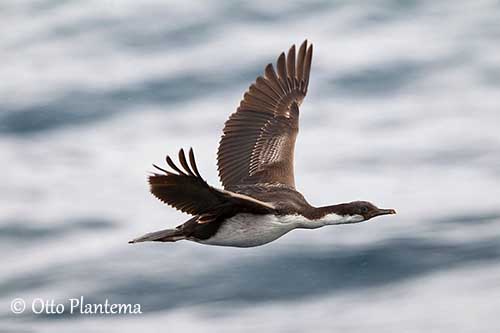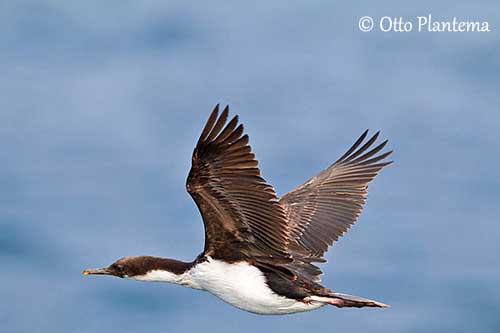
Fr: Cormoran de Crozet
Ang: Crozet Shag
All: Crozetscharbe
Esp: Cormorán de las Crozet
Ita: Cormorano delle Crozet
Nd: Crozetaalscholver
Sd: Crozetskarv
Photographer:
Otto Plantema
Trips around the world
Text by Nicole Bouglouan
Sources:
HANDBOOK OF THE BIRDS OF THE WORLD vol 1 by Josep del Hoyo-Andrew Elliot-Jordi Sargatal - Lynx Edicions - ISBN: 8487334105
A Complete Guide to Antarctic Wildlife by Hadoram Shirihai and Illustrated by Brett Jarrett - Edited by Guy M. Kirwan - ALUL.A Press Oy, Finland - ISBN 9519894705
Blog officiel du district de Crozet – TAAF
Time budget and diving behaviour of chick-rearing Crozet shags
By Y. Tremblay, T.R. Cook, and Y. Cherel
African Journals Online - AJOL
POPULATION, BREEDING, DIET AND CONSERVATION OF THE CROZET SHAG PHALACROCORAX [ATRICEPS] MELANOGENIS AT MARION ISLAND, 1994/95–2002/03
South Africa to the Antarctic Pack Ice
Part 5 - Marion & Prince Edward Island
Crozet Shag
Leucocarbo melanogenis
Suliformes Order – Phalacrocoracidae Family
INTRODUCTION:
The Crozet Shag is part of the « blue eyed shags » complex and the Imperial Shag group, but it slightly differs from other cormorants in plumage, with less white on back, scapulars and forewing-coverts. It is now a full species, endemic to Crozet, Marion and Prince Edward Islands.
This species is sedentary in its small range, and its populations seem to be fairly stable.
DESCRIPTION OF THE BIRD:
Biometrics:
Length: 70 cm
Wingspan: 125 cm
Weight: 1700-2700 g
The Crozet Shag adult in breeding plumage has black upperparts with green to bluish sheen on the upperwing-coverts. There is no white on upper back and very few or no white on outer scapulars. The white forewing-coverts are limited in extent.
The underparts are white from chin to undertail-coverts. The outer sides of thighs are black with blue gloss. The underwing is blackish with some white at base of leading edge. The tail is dull blackish with whitish shafts at base.
On the head, crown, cheeks (much of ear-coverts) and hindneck are black. Only the lower edge of the ear-coverts is white.
There is a long, erectile crest of upcurved feathers on crown, and a variable amount of white filoplumes above and behind the eye. Some other filoplumes are scattered on head, neck and back.
The bill is blackish-grey tinged brown, slightly paler at tip. The eyes are dark brown, surrounded by conspicuous blue eyering. There are two prominent yellow to orange warty caruncles on the sides of the forehead. Legs and webbed feet are pink with some grey areas.
Both adults have similar plumage, but male is larger than female, especially with longer wings and tail.
The Crozet Shag in winter plumage lacks crest and filoplumes. The facial skin is duller. The white forewing-coverts patch is absent or much reduced.
The juvenile is mostly brown and white with dull facial skin. The blue eyering is absent. Lesser and median wing-coverts have pale tips.

RANGE:
The Crozet Shag is found on Prince Edward, Marion and Crozet Islands where it is largely sedentary.
HABITAT:
The Crozet Shag breeds along the coasts on cliffs, slopes with vegetation or not, flat ground and boulder beaches. The colonies are established in areas protected from strong winds.
They usually roost on cliff tops, stacks or headlands.
It forages up to 6 kilometres over the continental shelf at Crozet islands, but at only 400 metres from the coast at Marion Island.
CALLS AND SONGS:
The Crozet Shag is noisy at colonies where it produces a repeated barking “kok-kok-kok” or “heh-heh-heh”.
BEHAVIOUR IN THE WILD:
The Crozet Shag feeds on squid and octopus, molluscs, crustaceans and fish, the latter usually caught by pursuit-diving. It feeds mainly at the bottom on benthic preys.
It forages alone, but small flocks can be seen fishing co-operatively.
The Crozet Shag is monogamous, but the pair-bonds last only a single season. Information about displays is currently absent, but we can suggest that courtship displays are similar to those of most Phalacrocoracidae, including “wing-weaving” while the bill is pointed upwards and forwards to expose the bright-coloured face pattern, and “gargling” with the nape touching the rump while the bill is wide open. These displays are accompanied by calls.
The male brings nest materials and the female arranges them and builds the nest, a truncated cone made with mud and vegetation.
The Crozet Shag is largely sedentary. After breeding, juveniles and adults may perform local movements at Crozet, but only over short distances.
The flight is powerful with regular, continuous wingbeats, sometimes interspersed with occasional glides. Over water, the flight is usually low over the surface, but over land, the bird flies higher.

REPRODUCTION OF THIS SPECIES:
The breeding season varies depending on colonies. The egg-laying takes place between late October and February at Marion and Crozet Islands, and egg-laying in June was reported in 1984 on Prince Edward Islands.
The Crozet Shag breeds in small colonies of up to 50-55 pairs, established on cliffs and boulder beaches.
The nest is a truncated cone made with grass and algae cemented together with mud and guano. Such nest is built on bare ground or in vegetation. It may be reused year after year, but by a new pair.
The female lays 1-5 eggs (usually 2-3). Both adults incubate during about one month (28-31 days). At hatching, the chicks are naked, but very soon, they have greyish-brown down. They are fed by both parents and fledge between 50 and 63 days after hatching. They still depend on parents for one month.
PROTECTION / THREATS / STATUS:
The Crozet Shag may suffer some natural predation of eggs, but bad weather conditions and rough sea are the main causes of nest failures.
This species is common on Crozet with about 810 pairs. On Marion, there were only 272 pairs in 2002/2003. On Prince Edward Islands, the population is estimated 39/50 pairs over 6-7 breeding sites (December 2001).
Declines are reported on each island, but the global population reaches 1200 pairs and is considered not globally threatened. This population appears fairly stable. In addition, Prince Edward is a restricted nature reserve, very little visited by humans.